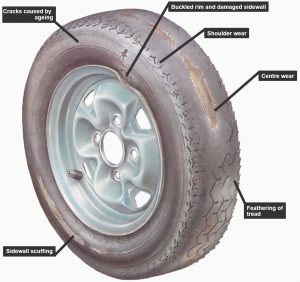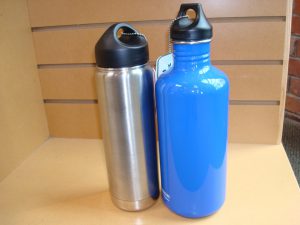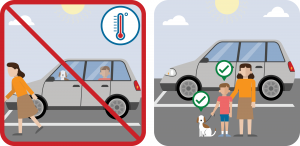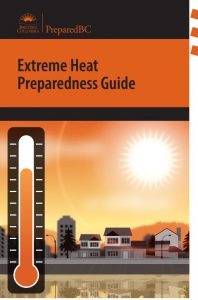
A hot climate isn’t usual for British Columbia (or Canada, either) but in recent years, we’ve seen higher temperatures and drier conditions. Here are some helpful ways to be cool and safe while driving in BC summer heat.
Similar to planning for winter travel, BC’s heat warnings and extreme heat emergencies (like heat domes) are conditions that drivers should prepare for, so they can be safe and comfortable on the road when temperatures soar.
It’s important to stay tuned to the weather forecast and understand the different types of events.
- A heat warning is when daytime and overnight temperatures are higher than usual and holding steady.
- An extreme heat emergency is when daytime and nighttime temperatures get hotter every day and are well above seasonal norms
When preparing to venture out it’s highly recommended that you do the following:
Check Your Vehicle
Just like in winter, BC summer heat places extra pressure on your vehicle’s engine — operating your air conditioning, idling in stop-and-go traffic or towing a trailer or boat.
Because your vehicle must work harder to keep cool, it’s important to check the oil and transmission fluid and ensure the radiator is filled with coolant/antifreeze. Check hoses and belts and ensure that the air conditioning is working properly.
Good vehicle maintenance will help protect your engine from overheating, which can cause wear and corrosion on your engine, or a breakdown. For more warm weather vehicle maintenance advice, see BC Automobile Association’s checklist
Tires Take a Hit
When the mercury climbs, the pavement you drive on is hotter than the air temperature, and the friction of your tires on the road further increases the heat on the tire, and the possibility of a blowout.
Check your tires for bubbles, cracks, uneven wear, cuts, bulges and blisters – signs of damage that could make them susceptible.

In addition to condition, tire pressure is also important in hot weather. Under-inflated tires flex more, which causes heat buildup that can result in failures. In the heat, the air pressure in your tires can increase, which is also a problem. Be like Goldilocks and make sure that pressure is “just right.”
And while thinking of tires, check your spare, and that you have the jack and tools needed for an emergency roadside change.
Travel “Emergency Ready”

Keep a well-stocked emergency kit in your car that includes water, non-perishable foods, jumper cables, a flashlight/headlamp (with extra batteries), sunscreen and a first aid kit. Dress for BC summer heat success by wearing natural, breathable fabrics, and sport sunglasses that sharpen your view and protect your eyes.
Also pack a long-sleeved shirt, long pants and a broad brimmed hat to protect you from sunburn, in case you end up outside, due to a vehicle mishap. Having a fan (hand or battery-operated) aboard, can help keep you cool when other systems break down.
On extra-hot days, stock a cooler with ice, cold water and wet cloths (to apply to your neck) to prevent you from overheating and include a jug of water for your radiator (or for you, if your other water runs out). It’s important to hydrate frequently!
When to Travel
If you can’t prepare adequately to manage heat risks during travel, then remove/reduce the hazards by travelling at a different time of the day. If possible, drive in the early morning or later in the evening. The cool weather will be easier on your car’s engine and possibly you and your passengers, too.
NOTE: Dusk and dawn are when animals are most active and most likely to be near highways and roads. Watch closely for wildlife, and scan the edges of the road as you drive.
If you’re on a solo trip, or in remote or unfamiliar areas, set up a check-in system, so someone will know approximately where you are at all times, and can contact emergency services if you don’t arrive or check in as planned.

Consider Your Passengers During BC Summer Heat
Temperatures of 31 C or higher can be dangerous for some people so think about whether elderly, very young or vulnerable passengers should be travelling at all.
Children are particularly sensitive to temperature extremes and the use of window shades can protect those riding in the back seat.
Never leave children or pets alone, for any length of time, in a parked vehicle. On a hot day, a stationary vehicle heats up extremely fast and permanent injuries or death could result. Look inside your car while you’re locking it, to make sure no one gets left behind. When it’s 27 C outside, the temperature in a parked vehicle can climb to 37 C in 10 minutes, 43 C in 20 minutes, and up to 50 C in an hour.*

Chill Out During Your Breaks
Take breaks every two to three hours – heat can make for drowsy driving.
Plan stops that will help you stay cool and refreshed, especially when temperatures are higher than normal. For example, find out if any provincial parks along your route have a lake or river for a dip. If you’re passing through an urban area, a shopping centre, library or recreation centre can provide refuge from baking-hot temperatures.
Your dashboard, steering wheel and seats can increase the temperature in your vehicle cabin, so park in the shade if possible, and use a sunshade for the windshield. In extreme heat, covering the steering wheel and dashboard with a towel, can help.
If your dog is travelling with you, be aware that asphalt, brick, concrete or sand, can get hot enough burn their paws. The air temperate may be a moderate 25 C but on sunny days the road surface can reach 51 C. If you can’t hold the back of your hand against the pavement for seven full seconds, then it’s too hot for your pooch to pad around on. (BONUS TIP: stay off artificial grass — it gets hot and retains heat).

Chances are if you live and travel in Canada, you’re likely more wary of hypothermia than hyperthermia. But things like heatstroke can happen, even in the Great White North. Symptoms include rapid breathing and heartbeat, extreme thirst, and decreased urination with unusually dark yellow urine. If that happens, cool down immediately in cold water or with cold compresses, and seek emergency medical attention or call 911.
Stay aware and be prepared to travel safely and comfortably when the heat is on, in BC, and other places where summer can serve up sizzling temperatures.
To learn more about what you can do to prepare for heat warnings and extreme heat emergencies, see Prepared BC’s Extreme Heat Preparedness Guide:

*Information from National Highway Traffic Safety Administration converted from Fahrenheit to Celsius.
More summer safety blogs:
How to Prevent Vehicle Fires While Travelling on BC Highways
What You Need to Know About Travelling During BC Wildfires
Only You Can Prevent Roadside Wildfires
Seven Ways to Safely Wrap Up Your Summer on the Road
Join the discussion